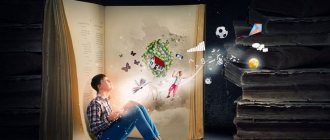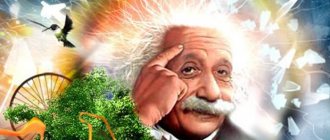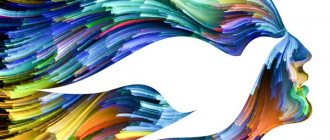Take a moment to imagine the world 50 years from now. How do you do this - see pictures, build logical chains, or feel real fear in your body? Or maybe you feel irritated because those around you are already talking about the future and all its versions are similar to each other? How similar is what appeared in your imagination to these familiar versions - and to the present? What about your past experience?
This is one of the main problems in the study of imagination: it either repeats already received impressions and sometimes combines them, or creates completely new images and reactions. Kant was the first to notice this and proposed to distinguish between productive and reproductive imagination.
Kant assumed that a person is capable of both. But not everyone agrees with him. On the one hand, how is it even possible to gain access to something that did not yet exist - unless through divine revelation (and therefore mystical descriptions have always accompanied discussions of the imagination). On the other hand, the response that is provoked by a mental image is always distorted or transformed, that is, it cannot completely coincide with the response to a physically present object. This means that imagination always brings something new to reality.
Philosopher Jennifer Anna Gosetti-Ferenci, in The Life of the Imagination (2018), defines imagination as: “The ability of the mind to imagine, which allows for significant and meaningful transformation of what is already given.”
To understand this abstract formulation, let’s look at the five modes of imagination that the researcher identifies:
1. Internal imagination implies that the object or impression you are imagining is not present with you at the moment. But the images that arise in the mind can cause quite tangible emotional and sensory reactions. The simplest example is a child's image of monsters under the bed at night.
2. Concrete imagination: Seeing as, aesthetic and symbolic perception relies on an object that is actually present, but allows you to load it with additional or even contradictory meanings. For example, in the drawn triangle you see a mountain.
3. Hypothetical thinking (thinking against facts) allows us to think in a conditional mood, creating conceptual scenarios that differ from the current state of affairs. Hypotheses can also be accompanied by sensory reactions or conscious attempts to imagine one’s feelings, but the starting point here is precisely some kind of statement, like “What if I had been born in the 18th century?”
4. Pretending involves not just reactions, but also physical activity. For example, when children imagine themselves as ghosts or adults; when actors perform roles on stage; even when people deceive each other and try to be convincing.
5. Creativity is expressed in the creation of new objects. The main thing is that they are formalized and can be expressed: not just an intuition that slipped into the consciousness and disappeared, but a plan from several points, a sculpture, a melody, or the same acting image. Creativity builds on all other forms of imagination, but leads them to a specific result.
Imagination and empathy
Imagination is often associated with creative activity—more precisely, with art or scientific discoveries.
Gosetti-Ferenci examines how a successful analogy between one’s own body in a bath and metal in water helped Archimedes discover the relationship between body mass and the buoyant force of a liquid (according to legend, Archimedes needed to check whether the crown of a local ruler was made of pure gold).
Analyzing jazz improvisation, the researcher notes that musicians always create new sequences, using pre-conceived patterns and at the same time reacting to each other right during the game. The Knife recently talked about how imagination works in contemporary dance: choreographers invent fluid and posthuman bodies, drawing on different philosophical theories.
But let's find out how often and in what way imagination is used not only in science and art, but also in our everyday life. Phenomenology will help with this - a philosophical direction that studies interaction with the world from the first person. This concept is based on a cognizing subject, all of whose experiences are directed towards a certain object. But phenomenologists suggest that the subject perceives the world not only from the point in which he or she is now located, but from a variety of possible (potential) points.
For example, when you look at a cup, you only see one side of it, but at the same time you can roughly imagine what it would look like from other sides. This is how a solid object of a cylindrical shape, with a handle and a bottom, appears in perception.
“Potentiality, of course, presupposes an embodied subject with some set of skills: turning things over or examining them, taking different positions, moving in space, […] looking at things from different angles,” Gosetti-Ferenci clarifies, referring to ideas one of the greatest phenomenologists of the twentieth century, Maurice Merleau-Ponty.
Merleau-Ponty's main thesis is that perception and imagination are rooted in the body. When we talk about the need to “look at the situation through someone else’s eyes,” we literally mean this: in order to show empathy, we seem to take the position of another in space and in relation to all other objects.
When we watch a performance in which the performers do something dangerous, we simultaneously exist in at least two positions: in the chair and on the stage, experiencing the states of the performers - albeit weakened, but still palpable.
But where are the limits of such imagination? Through whose eyes can we not look at the world?
Functions
- Prompting activity with the help of a bright, attractive image of its result, means and methods of implementation, generalized ideas and specific plans.
- Regulation of behavior in an uncertain, problematic situation with the help of images of alternative actions and their consequences.
- Emotional self-regulation, autopsychotherapy, illusory satisfaction of needs. This function comes with the risk of escaping reality. Replacing reality with gaming images is one of the consequences of gambling addiction.
- Organization of cognition - reconstruction of an object according to description, completion of missing elements, modeling.
Who is scarier: a jaguar or a European?
“What we call blood turns out to be the ‘beer’ of the jaguar,” wrote Brazilian anthropologist Eduardo Viveiros de Castro in his 2014 book Cannibal Metaphysics.
Like many anthropologists, he studied “other” cultures, such as the Indians, but for an unusual purpose. If for many years the task of anthropology was to describe “strange” alien practices as accurately as possible, then de Castro suggested turning to the Amazonian natives in order to reconsider the views of Western science on the structure of the world.
One of Castro's main discoveries was interspecies perspectivism, that is, the ability to look at the world not only through human eyes, but also through the eyes of a jaguar, a dead man, a spirit. Castro recalls an anecdote that the ethnologist Claude Lévi-Strauss cited in his texts: having discovered America, the Spaniards tried to test whether the natives had a soul, and the natives threw the invaders into the water to find out if they had a body - whether it would rot.
“The Europeans never doubted that the Indians had a body (animals do too); The Indians never doubted that Europeans had souls (both animals and the ghosts of the dead have them), writes de Castro. - Animals and other non-humans endowed with souls “see themselves as individuals,” and, therefore, “they are individuals” <...> But what exactly these individuals see, and, therefore, what they actually are personalities are precisely the philosophical problem that native thought poses for itself.”
Shamans come closest to solving this problem: during the ritual they literally turn into an animal, exist in its body and look through its eyes. According to Viveiros de Castro, perspectivalism and shamanism exhibit a fundamental difference between cognition in Western and many non-Western cultures:
«[In the West] to know is to objectify;
to be able to distinguish in an object what is inherent in it from what belongs to the cognizing subject and what was projected onto the object in this capacity - illegally or inevitably.
<…> Indian shamanism is inspired by the opposite ideal: to know means to personify
, to take the point of view of what should be known.”
Imagination in general goes hand in hand with objectification, especially the collective imagination, which is expressed in myths and stereotypes or, more precisely, is subject to them. This imagination allows Europeans who have never immersed themselves in, say, Asian cultures, to imagine incense, noisy streets and people who look the same on the fly. Ideas about a mystery woman or a woman - a loving mother arose and took hold in the imagination, and in order to imagine a woman leader or a calculating criminal, you need to try.
So Plato was not entirely wrong when he wrote about the dangers of imagination.
How images arise
There are various ways to create them.
Emphasis is the highlighting of any parts, features or properties. The following techniques are used here:
Typification is a generalization of an image and its emotional saturation. Many literary heroes are shining examples of typification. For example, Gogol’s landowners from “Dead Souls”: Manilov is a barren dreamer, Korobochka is a greedy hoarder, Nozdryov is a dashing reveler.
Combination is the creation of a new one by combining parts of an existing one.
Exaggeration is the deliberate strengthening of any characteristic feature or phenomenon. For example, the expression: “This morning I drank ten liters of coffee” would be an exaggeration.
Exaggeration and understatement. Gulliver can be considered a striking example of both.
Combination is a combination of elements that already exist in new combinations.
A Look at the Root
Yet imagination is also a tool that creates a better future. “To imagine the future is to change it,” writes urban futurist Darran Anderson. Many of his colleagues talk about the radical imagination—as left-wing political strategist Patrick Rainsborough defines it as the kind of imagination that gets to the roots of systemic problems (radical also means “root”).
An example of radical imagination is science fiction literature. Sci-fi is often treated with disdain, but the best examples of the genre carry a truly powerful utopian charge. To describe it, researcher Darko Suvin introduced the concept of novum - this is a law, a technical invention or a changed state of nature, which forces us to reconsider all the principles by which life flows.
Suvin called science fiction the literature of cognitive defamiliarization.
Unlike free imagination, which does not always develop linearly and logically, sci-fi requires authors to consistently develop a new world at a variety of levels - from material infrastructures to social structure.
The value of long literary texts lies in the detail that theories rarely achieve.
But, in addition, science fiction writers always start from the current moment - they defamiliarize (describe from the outside) reality, and therefore criticize it. Here are some famous examples of science fiction literature becoming part of, if not the basis of, liberation movements.
American science fiction writer Ursula Le Guin
became famous for her feminist utopias. For example, in the novel “The Left Hand of Darkness” peopled the world with people with consistent hermaphroditism: the gender of the heroes and heroines changed cyclically along with the position of the planet, and most of the time was completely absent. In 1969, the career and family opportunities that such a novel would open up for everyone seemed almost unthinkable—even though feminist fiction, while much less well-known, had already been decades old by that point.
Afrofuturist Octavia Butler
made black people the main characters of her novels, while white science fiction writers usually simply forgot about their existence. One of the leitmotifs of it, and indeed of all Afrofuturism, was the imagination of the golden age of Africa: both in the past, before colonization, and in the future, when racism has been overcome.
In China, the rise of sci-fi began at the turn of the 2000s and 2010s. The government began to support fantastic literature, believing that with its help it would train the imagination of citizens and they would be able not only to produce, but also to develop innovative technologies. Meanwhile, the authors (most famously Han Song
,
Chen Qiufang
and
Liu Cixin
) disguise social criticism as science fiction: they write about the general surveillance society that already exists in China, emphasize how secretive and opaque the power structures are, and sometimes use very specific images - for example, they describe a “huge field trash" near Guangdan, where Chen Qiufang grew up and where migrant workers now "use their own hands to disassemble pieces of electronic devices, melting metal in fire or dissolving parts in acid."
In general, science fiction writers rely on real problems when they imagine a utopian (or more often dystopian) future. Futurologists do the same, who engage in forecasting no longer for the sake of art, but advise large businesses and political campaigns.
Sociologist John Urry wrote the book “What the Future Looks Like” in 2021, in which he identified six techniques by which humanity prepares for tomorrow:
1. They draw analogies with the past - for example, when they now predict how new technologies will affect society, they remember how the world has changed after the advent of telephone communications or computers. These versions are often fairly accurate in content, but not in timing, because they rarely account for game-changing surprises (like the silicon processors that made computers explode in power in the 1960s).
2. They study which futures did not materialize and why - for example, it became clear that forecasts in which new technologies instantly replace old ones rarely make sense. More often they coexist for a long time - it’s both a matter of social habits and economic benefits.
3. Express their fears in dystopias. Urry identifies five common dystopian stories:
- collapse of society due to resource depletion; — installation of total control; - atomization, in which human communication becomes impossible due to psychological changes or external conditions; - the emergence of many rules and laws that lead to loss of wealth; - seizure of power by cyborgs.
4. They create utopias.
5. Extrapolate elements of the present - describe how a certain trend that has already formed in the present will determine the future.
6. Scenario planning (retropolation) is the most interesting option: first they describe the world after a given amount of time, and then analyze what events and at what moment will have to happen in order to get to the described state from the current one. An example of retropolation is the book “The World We Made” by Jonathon Porritt, one of the leaders of the green movement. In it, the narrator speaks from 2050, but all the time he remembers what events allowed humanity to switch almost entirely to renewable resources and significantly reduce economic inequality.
True, this book also illustrates that the political imagination rarely manages to capture all the important issues: Porritt does not write about how to cope with gender or racial inequality.
Examples from life.
People often imagine. Waking up early in the morning, a person mentally chooses clothes, combining his things in his head.
After leaving home, we think about the shortest route to work or school, taking into account weather changes or other conditions.
After a hard day's work, we figure out what to cook from the available ingredients.
But it’s not only in everyday life that we use our imagination. For example, during a renovation, we mentally arrange the furniture around the room and imagine what the room will look like after the renovation.
When a person is alone with his thoughts, a great imagination is activated. Being alone, you can penetrate to a deep level of imagination and find answers to all the answers that interest you.
Against inspiration
We have shown imagination as a set of techniques that can be consciously applied: from the smallest and most general (seeing as, pretense, empathy) to specific algorithms (retropolation, novum creation, perspectivism). But imagination is often associated with mysterious processes in which a person does not seem to fully control and understand himself. They talk about inspiration, insights, flights of fancy.
But what happens if you simply surrender to free association? If you look at works of art whose authors often talk about inspiration, instead of strong work, you often see a set of stereotypes, held together in different sequences. This can work because these stereotypes often make up our common natural field. But we get truly strong impressions, that same utopian impulse, when we come across ideas that go against common sense.
Actually, common sense is the main enemy of imagination, or rather, the main point to which it is interesting to apply imagination.
Common sense makes many of us think that looking at the world through the eyes of a jaguar will not work; that the inhabitants of the Earth are unlikely to ever become consistent hermaphrodites.
But there are ideas that seem to be much less shocking, but at the same time seem completely impossible. For example, the idea of breaking the causal relationship between work and earnings: people will still work and produce goods, but they will not receive money for this, but in the form of an unconditional basic income - monthly payments for everyone that do not depend on from nothing at all and on which you can lead a fairly decent life. Can you imagine yourself in such a world in the same 50 years? What values would there be in this reality, what problems, what professions, what art?
If it’s difficult to imagine, then it’s not just like that: the belief that this cannot be so has been formed for decades. Nick Srnicek and Alex Williams write about this in Inventing the Future, and it is one of the most powerful studies of common sense in recent memory - detailing how it is cultivated in think tanks, the media, economic programs, and how it is slowly permeating everywhere .
Physiological basis
Combinations of neural connections are formed at conscious and unconscious levels
Physiological processes responsible for the functioning of the imagination regulate the vital processes of the body.
Complex processes occur in the brain, during which nerve connections are activated and redistributed.
As a result of these processes, new neural combinations appear, which are the basis of the physiology of imagination.
Combinations of nerve connections are formed:
- at the unconscious level: from a spontaneous reaction in the cerebral cortex to various stimuli (for example, sleep or hallucinations);
- on a conscious level: in the process of a person’s independent creation of new images, several parts of the brain work (in all voluntary types of imagination).
The formation of new connections is not a random process; it can be described as the creative work of the brain.
Imagination influences many physiological processes: the functioning of organs, the level of activity of glands, metabolic processes. For example, when a person imagines a tasty dish, he salivates more.
When thinking about intense physical activity, you may notice subtle muscle activity. Consequently, imagination is closely related to human life processes and behavior.
Varieties
Imagination is divided into two groups, each of which has its own subgroups:
- Active is a purposeful, volitional act. This type of imagination is used, for example, by writers. To create a story (what is that?) or a note, they have to use their imagination on purpose. Active imagination, in turn, is divided into: recreating - mental appeal to existing images (remember what your mug looks like);
- creative - with its help we come up with something new (imagine yourself on a desert island, sitting on the top of a palm tree in flippers and with an iron in your hand).
- dreams - these images arise involuntarily;
From bills to hi-tech
The industrial revolution of the 19th century and the information revolutions of the 20th century succeed each other. Everything goes towards increasing, complicating and accelerating. The importance of developed imagination also increases.
Half a century ago, children at school were taught to count on an abacus. Modern life cannot be imagined without computers and high-speed Internet - an additional reality that creates an absolute connection between people.
Humanity is on the verge of a new technological breakthrough - robots and artificial intelligence. Before we even had time to think about what this threatens us with, some even got scared, when a new scourge - the coronavirus. Nature forces humanity to unite, otherwise the epidemic cannot be dealt with. Only united humanity will be able to move into a new phase of development - the urethral one.
As strange as it may sound, a developed imagination can help us survive the pandemic.
Development methods
In the modern world, creative people are in great demand. That's why there are trainings and seminars on developing imagination.
Such exercises are designed not only for children, but also for adults.
Brief recommendations for the formation of imagination allow parents to help children improve their skills. To begin with, adults must create a sensory environment, i.e. introduce the child to different objects and phenomena. The baby should actively play and talk with peers. It is oral speech that contributes to the emergence of abstract thinking.
Important! We need to support any creative endeavors: drawing, playing music, sculpting, etc. Adults can develop their imagination too
To do this, they should constantly train. For example, come up with new properties for an existing item or try to come up with something from scratch
Adults can develop their imagination too. To do this, they should constantly train. For example, come up with new properties for an existing item or try to come up with something from scratch.
Knowing the exact characteristics of imagination and the characteristics of its manifestation, any person can develop this type of mental activity. Additionally, you can count in your head, read books, watch movies and learn to analyze your environment.
The more sensory experience a person has, the higher the likelihood of fantasies. Meditation and other trance techniques can help. It is useful to recreate the past day every day before going to bed. With regular practice you will be able to achieve good results.
From the weakest to the top of the hierarchy
It was not without reason that our distant ancestor had the imagination many thousands of years ago. Without it, he could not survive in the primitive savannah.
Primitive people, having neither fangs nor claws, not possessing the speed of a cheetah or the strength of a lion, found it very difficult to compete with animals for a place in the sun: to get their own food and not become it themselves.
75,000 years ago, our ancestor was the weakest on the savannah, on the verge of extinction from starvation. The human population was about 2000 individuals, the descendants of which are modern humanity. In science, this period is usually called the “bottleneck effect.”
Besides us, Homo Sapiens, there were seven other currently known species of humans. After a short time by historical standards, our species destroyed all other species of people, exterminated most animal species on the planet and took first place in the food hierarchy. How did we manage to do this?
The evolution of one dream of humanity
Imagination is more important than knowledge, because knowledge is limited, but imagination embraces everything in the world, stimulates progress and is the source of its evolution.
Albert Einstein
The idea of flying in the air originated among people many thousands of years ago. Even the ancient Egyptians found drawings and sculptures of people with wings. The same images would later appear among the Greeks and Romans. Tales of the peoples of the world reflect this same desire. For example, the flying carpet is present in Russian and Middle Eastern fairy tales.
This dream remained a utopia until Leonardo Da Vinci, who stood out even among the geniuses of the Renaissance. There is no such person who has not heard of the Mona Lisa. We perceive Leonardo first and foremost as the greatest artist. But the “universal man” himself considered himself primarily a scientist and engineer.
He was interested in mechanics, mathematics, architecture, and the environment. In the 15th century, Leonardo Da Vinci described the valve of the right ventricle of the heart, discovered that the age of a tree is determined by the annual rings, created a camera obscura, and constructed canals and dams. His inventions are considered to be: a prototype of a tank, a diving suit or spacesuit, a self-propelled cart (a prototype of a car). Many other engineering ideas are captured in the master’s drawings, drawings and sketches. His aircraft are of greatest interest.
Leonardo, inspired by the flight of birds, dreamed of aeronautics. His drawings and sketches show for the first time how a flying machine can be built. Leonardo Da Vinci worked on different types of aircraft. He created the first ornithopter, propeller, and parachute. The brilliant inventor, who with the power of imagination looked many centuries into the future, did not realize his ideas due to the weak technologies of that time. Leonardo Da Vinci's dream of aeronautics was realized five centuries later by Igor Sikorsky.
Mister Helicopter
An important role in the life of the future aircraft designer was played by his mother, who devoted her life to raising five children. She was most interested in the art and inventions of Leonardo Da Vinci. The mother's hobbies fell on fertile soil. The sound child loved to listen to his mother's stories about the infinity of the Universe and mysterious stars. But most of all, his childhood imagination was struck by stories about Leonardo Da Vinci and his idea to create an “iron bird” - a flying machine that rose into the air with the help of a powerful propeller.
His mother instilled in the future great aircraft designer a love of music and literature. Little Igor's reference book was Jules Verne's novel “Robourg the Conqueror,” which describes an aircraft that vaguely resembles a helicopter. One day, after reading this novel, the boy dreamed that he was on board a flying ship, from the windows of which one could see the sea and an island with palm trees. This dream will come true 30 years later - he will see all this on board the amphibious aircraft he designed.
After graduating from high school, Igor’s parents assigned Igor to the Naval Cadet Corps in St. Petersburg, where their eldest son was already studying. It was a privileged educational institution, but Igor was not attracted to a military career, even one related to the sea. He kept track of all the technical innovations and designed something in educational workshops during his off-hours. The desire to build airplanes and fly them finally matured after newspaper reports appeared about the first flights of the Americans - the Wright brothers.
Igor Sikorsky leaves school and devotes his future life to realizing his dream (you can read more here).
Sikorsky created about 15 types of aircraft. After his inventions, multi-engine aviation began to develop. Since 1939, he switched to designing helicopters. In 1967, Sikorsky helicopters made the world's first flight across the Atlantic Ocean, and in 1970, across the Pacific Ocean, albeit with in-flight refueling. His inventions marked the beginning of a new era, and the designer was given the nickname “Mr. Helicopter.”










